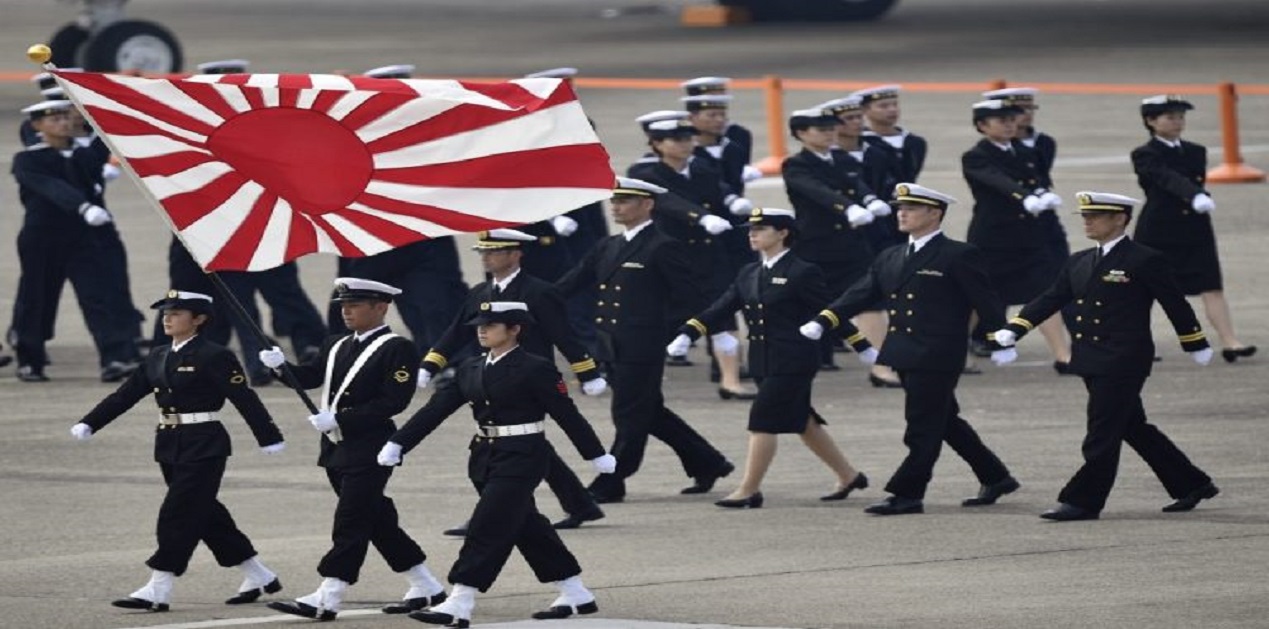Japan’s security posture seems to be heading for a dramatic overhaul as it feels compelled to respond to the emerging challenges in the altered security environment in its neighbourhood. China’s belligerence in territorial issues and North Korea’s nuclear and missile tests have awakened Japan to think seriously about safeguarding its own security. It may be recalled that when North Korea fired missiles in the recent past, they flew over Japan’s northern island of Hokkaido, exposing Japan’s vulnerability and to external security threats. This compels Japan to seek means to strengthen its own capability to deter attack from potential unfriendly countries. This was a priority for the Shinzo Abe government and continues to be the same for the Fumio Kishida administration.
The domestic response to any activism against enhancing its defence profile is viewed critically and sometimes frowned upon. However, despite strong aversion on the part of the people to anything that might be seen as returning to its past role, the government in office cannot afford to remain silent in the wake of threat lurking in its neighbourhood. The government policy also seems to have been influenced by the feeling that Japan cannot afford to depend on the US nuclear umbrella as the signals are too ominous from Washington. This feeling was sharpened during the Donald Trump administration when the US continued to put pressure on Japan to increase its share of security burden, with no sign of any finality. The world also seems to have developed cold feet after the fiasco in Afghanistan and feels that the US is no longer prepared to be the world’s police man and thus be the net security provider to its allies despite having treaty commitments.
In a policy speech on 6 December 2021 at the Extraordinary Diet session, Prime Minister Kishida said he will conduct a sweeping review of the country’s defence policy amid a volatile security climate. Listing among others such as fortifying the economy against global inflation by ensuring that wages were raised to protect livelihoods and boost consumption, Kishida spelt out his policy vision in explaining why his government was seeking a record supplementary budget of 35.9 trillion yen. This includes a request of 773.8 billion yen in extra defence spending for the fiscal ending in March 2022, bringing the overall budget to a record 6.1 trillion yen. This includes purchase of new missile batteries, maritime patrol planes, and air-to-air missiles, among other things.[1] Kishida realised that since the debate to revise the war-renouncing Constitution since its enactment in 1947, particularly Article 9 peace clause, is too complicated, considering acquiring weapons for the pre-emptive strike on enemy bases was felt a better alternative option.[2]
Taiwan is another worrying factor for Japan. China continuously threatens to use military force against Taiwan to annex it as it considers Taiwan as a breakaway province of China. This has created a bigger flashpoint in the region, than much perceived South China Sea. Though Japan’s rising military spending might lead to an escalating arms race in the region, this is an inevitable consequence of and reaction to China’s increasing belligerence. Addressing virtually a Taiwanese think tank, the Institute for National Policy Research, on 1 December 2021, former Prime Minister Abe observed that Sakishima Islands and Yonaguni Island, part of the Senkaku Islands chain, are a mere 100 kilometers or so away from Taiwan. Therefore, an armed invasion of Taiwan would be a grave danger to Japan.[3] This is causing jitters to Japan as Chinese control of the island would threaten key maritime trade routes that supply Japan with oil and other goods. Increased Chinese incursion into the area would also provide it with bases for unfettered access to the Western Pacific. He warned China that Japan and the US could not stand idle if China attacked Taiwan, and Beijing needs to understand this. The Kishida administration therefore feels that Japan shall be able to move more quickly with anti-submarine missiles, maritime patrol planes and military cargo jets.
Japan is host to major US military bases, including on the southern island of Okinawa, a short flight from Taiwan, which would be crucial for any US support during a Chinese attack. There are about 55,000 American forces stationed in Japanese bases and Japan therefore wears the ‘shield’ and hosts the “sword”.
As per the revised Taiwan Relations Act,[4] the US is bound by law to provide Taiwan with means to defend it. While there are some ambiguities about whether the US would send forces to help Taiwan in a war with China yet the US Secretary of State Antony Blinken said in November 2021 that the US and its allies would take unspecified “action” if China were to use force to alter the status quo over Taiwan.
Japan also toyed with the idea of buying an American missile defence system, known as Aegis Ashore for the defence of Japan, which it wanted to deploy in northern and western Japan. Aegis Ashore represents a good form of defence for Japan in principle. But the cost of hardware adjustments, necessary to ensure that rocket boosters would not fall on Japanese territory, would be prohibitive. Finally, the government in Japan under Abe administration decided to cancel the idea and looked for alternatives that could serve as a shield to intercept incoming missiles. It remains unclear if Japan can revisit this option in the future.
Among the alternatives is to develop the ability to mount a missile counterattack. Japan is presumably already working on this. When Japan released new defence guidelines in July 2021,[5] the government indicated that it would acquire missiles that could be used to attack enemy warships or even land-based targets.
The latest injection of additional fund shall enable Japan to upgrade surface-to-air missile launchers on islands at the edge of the East China Sea and Patriot PAC-3 missile batteries elsewhere that are the last line of defence against any incoming North Korean warheads.
Kishida had made election pledges that his government’s goal would be to almost double defence spending to 2 per cent of gross domestic product (GDP). For decades, in principle Japan was committed to abide by its self-imposed cap of not exceeding its defence expenditure in excess of 1 per cent of its GDP. That is now going to be breached as securing the nation’s security has emerged as a priority. For now, the proposed supplementary spending combined with defence outlays for the current year will be about 1.3 per cent of Japan’s GDP. This would dwarf the 430 billion yen earmarked in an extra defence budget in fiscal 1019, and would include outlays for missiles and patrol aircraft, and for strengthening defence capabilities near the south western islands. It is a different matter that such a decision could trigger the revival of militarism that led Japan into World War II in the past.
Japan’s decision to increase defence outlays needs to be seen in the context of Japan seeking “new level” of defence cooperation with allies as a response to increased Chinese militarisation in the Indo-Pacific. Japan is also open to cooperate with the AUKUS security partners, the US, Britain and Australia, on artificial intelligence and cyber capabilities.[6] For the record, the AUKUS pact, agreed in September will see Australia acquiring technology to deploy nuclear-powered submarines, and is widely seen as a response to Chinese militarisation in the region, particularly in the strategically important South China Sea.
Japan is also strengthening defence cooperation by sharing defence technology, on maritime security, cyber security, and intelligence-sharing and so on with friendly countries such as India, Vietnam and Australia. Given China’s acrimonious ties with these countries, China would be furious with Japan for its stress on enhancing its defence profile. On its part, the US too is reaching out to the ASEAN grouping to extend support and assurance for help if China tries to disrupt the centrality of the organisation, as Antony Blinken’s recent maiden visit to Indonesia and Malaysia demonstrated. This was a clear intent of the Biden administration to augment diplomatic engagement amid China’s growing influence. All these actions mean that Japan can feel assured of support of many Asian friendly nations and its decision to enhance defence profile shall get endorsement.
The primary aim behind Japan’s aim to enhance its defence posture is not only to beef up its own security but to work in cooperation with like-minded countries to realise a free and open Indo-Pacific. From this perspective, though Japan was kept out of the AUKUS like India and neither was consulted, Japan welcomed the formation of AUKUS. While it may be too early to understand and evaluate the role of the AUKUS at this point of time there are many multi-layered efforts afoot to promote peace and stability in the Indo-Pacific region through cooperation in such areas as cyber capabilities, artificial intelligence and quantum technologies etc which are aimed to achieve the same objective. Japan is keen to deepen its special strategic partnership with Australia and elevate bilateral security and defence cooperation to a new level. Therefore, Kishida government’s decision to enhance Japan’s defence profile by acquiring new modern weapon system needs to be understood as a response to the changing security dynamics in the region and its immediate neighbourhood.
Endnotes :
[1]“Japan to supplement military spending in rush to bolster air and sea defences”, 26 November 2021, https://www.straitstimes.com/asia/east-asia/japan-to-supplement-military-spending-in-rush-to-bolster-air-and-sea-defences
[2]Walter Sim, “Japan PM Kishida vows sweeping defence review, outlines other priorities in policy speech”, 6 December 2021, https://www.straitstimes.com/asia/east-asia/japan-pm-kishida-vows-sweeping-defence-review-outlines-other-priorities-in-policy
[3]“Former PM Abe says Japan, U.S. could not stand by if China attacked Taiwan”, The Asahi Shimbun, 1 December 2021, https://www.asahi.com/ajw/articles/14492732
[4]https://www.ait.org.tw/our-relationship/policy-history/key-u-s-foreign-policy-documents-region/taiwan-relations-act/
[5]See, Rajaram Panda, “Japan’s Defense White Paper 2021: China Riled by Mention of Taiwan Straits”, 13 July 2021, https://www.vifindia.org/article/2021/july/22/japans-defence-white-paper-2021-china-riled-by-mention-of-taiwan-strait
[6]“Japan plans record extra defence spending with eye on China threat”, 19 November 2021, https://www.straitstimes.com/asia/east-asia/ex-japan-pm-abe-calls-for-tokyos-cooperation-with-aukus-in-ai-cyber
(The paper is the author’s individual scholastic articulation. The author certifies that the article/paper is original in content, unpublished and it has not been submitted for publication/web upload elsewhere, and that the facts and figures quoted are duly referenced, as needed, and are believed to be correct). (The paper does not necessarily represent the organisational stance... More >>
Image Source: https://www.overtdefense.com/wp-content/uploads/2021/05/1per1-768x509.jpg











Post new comment